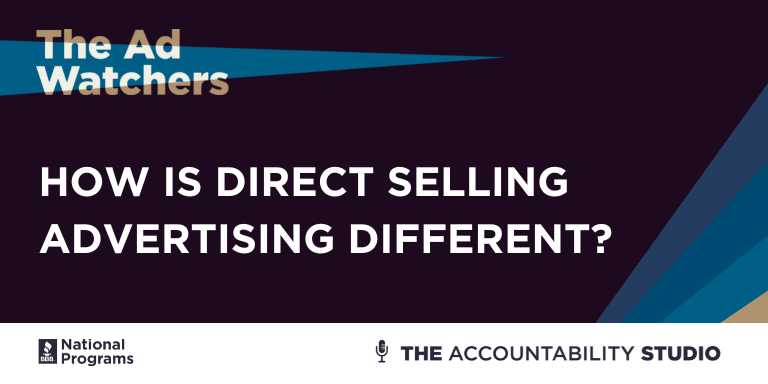
00:00 – This Ad Watchers episode provides insight into BBB National Program’s Direct Selling Self Regulatory Council (DSSRC) and how it works within the direct selling industry. Eric Unis, Senior Attorney at the National Advertising Division (NAD), and his colleague Annie Ugurlayan, NAD’s Assistant Director, are joined by guest Peter Marinello, the Vice President of DSSRC.
01:16 – Annie jumps right in, introducing Peter as a well-recognized champion of advertising self-regulation with over 25 years of experience. He began as a staff attorney at NAD in March of 1993 and later became NAD Associate Director in 1998.
02:22 – After the introduction, Peter answers a question from Eric about DSSRC’s inception. He explains that it launched in 2019 in response to a bad reputation of false product and earning claims in the direct selling market. The Federal Trade Commission (FTC) noticed the issue and threatened strict monitoring and regulations in an effort to encourage credibility and discourage bad actors. FTC Chair Marie Ohlhausen urged the industry to bring in an independent third party to administer a self-regulation program. The Direct Selling Association (DSA) responded by requesting assistance from the BBB National Programs. This led to the creation of DSSRC.
05:20 – Annie then asks Peter to explain how DSSRC differs from NAD and other self-regulatory programs. He details how, when developing DSSRC, they aimed to recreate some of the reputable features of NAD because the division is so highly regarded. They specifically wanted to mimic NAD’s transparency, objectivity, and accountability.
Despite using the division as an example, DSSRC has become quite a different organization. Unlike NAD, many of the DSSRC’s cases come from their own monitoring of the direct selling industry. They work with a third-party vendor that monitors social media posts and provides a portal where DSSRC can review any problematic claims. Peter also notes that the organizations’ funding models are different. While NAD receives funding from competitive claims and events like the NAD Conference, DSSRC is funded solely by the DSA. Peter believes this to be evidence of how committed the direct selling industry is to meaningful self-regulation.
07:24 – Next, Peter breaks down the typical case process at DSSRC. After reviewing content returned to them in the monitoring portal, if the DSSRC has discovered questionable claims, they will attempt to contact that company whose seller made the claim. Primarily, they will open cases through email, stating the claim, the reasons for concern, and specify a response date. If the company doesn’t respond by that date, the DSSRC sends a hard copy to the company headquarters. Their goal is to give the claimant every opportunity to participate in the process.
09:37 – Oftentimes, companies are completely unaware of the questionable claims made by their sellers on social media. When this is the case, the company may have the option to remove the post, and the case may be dropped. However, if the company does not have the post removed or if they are a repeat offender, DSSRC will move through the full regulatory process.
12:53 – To answer Eric’s question about the direct selling industry’s difficulties, Peter begins by giving an overview of what direct selling is. He explains that, unlike in other industries, there often is no brick-and-mortar location. Direct selling takes place in a one-on-one setting. The business owners buy products from a company to sell and keep a portion of each sale. He also addresses the “pyramid schemes” allegations that have plagued the industry. While bad actors do operate in the market, reputable companies, many of them DSA members, have worked to overcome the stigma. They are honest about their products and aim to meet real customer demand.
20:50 – Annie and Eric close out their interview by asking Peter about the expanding role of DSSRC. Its role is currently limited to product and earnings claims, but Peter expects their responsibility to grow. DSA recently asked them to administer a code of ethics that addresses problems outside their normal scope—such as inventory loading and illegal recruiting. He sees this as a door for the DSSRC to get involved in additional issues. Members of the DSSRC have also been communicating with the World Federation of Direct Selling Associations about developing a model similar to DSSRC. This gives Peter hope that the DSSRC might begin interacting globally.
24:05 – Before signing off, Peter encourages those interested in the direct selling industry to set realistic standards for what they can gain. “If you’re in it to get rich,” he says, “You’re going to the wrong place.” However, it is an interesting opportunity to make supplemental income.
26:05 – Eric and Annie wrap up the show with the following takeaways:
- Working to regulate a $35 billion industry, the DSSRC has effectively partnered with the DSA to regulate claims and improve the industry’s reputation after only a few years.
- Though sistered with NAD, DSSRC is different in many ways. While NAD’s cases are often challenges, most of DSSRC’s cases are monitoring cases. Additionally, NAD is funded by its challenges and conferences versus DSSRC, which is funded solely by the DSA.
- DSSRC may expand soon due to its early success. Self-regulation has been so beneficial to the direct selling industry that the role of the DSSRC will likely grow as the DSA identifies more regulatory needs.
Visit to Learn More: NAD FAQs
Contact Information: nad@bbbnp.org
Listen to the full episode here.

